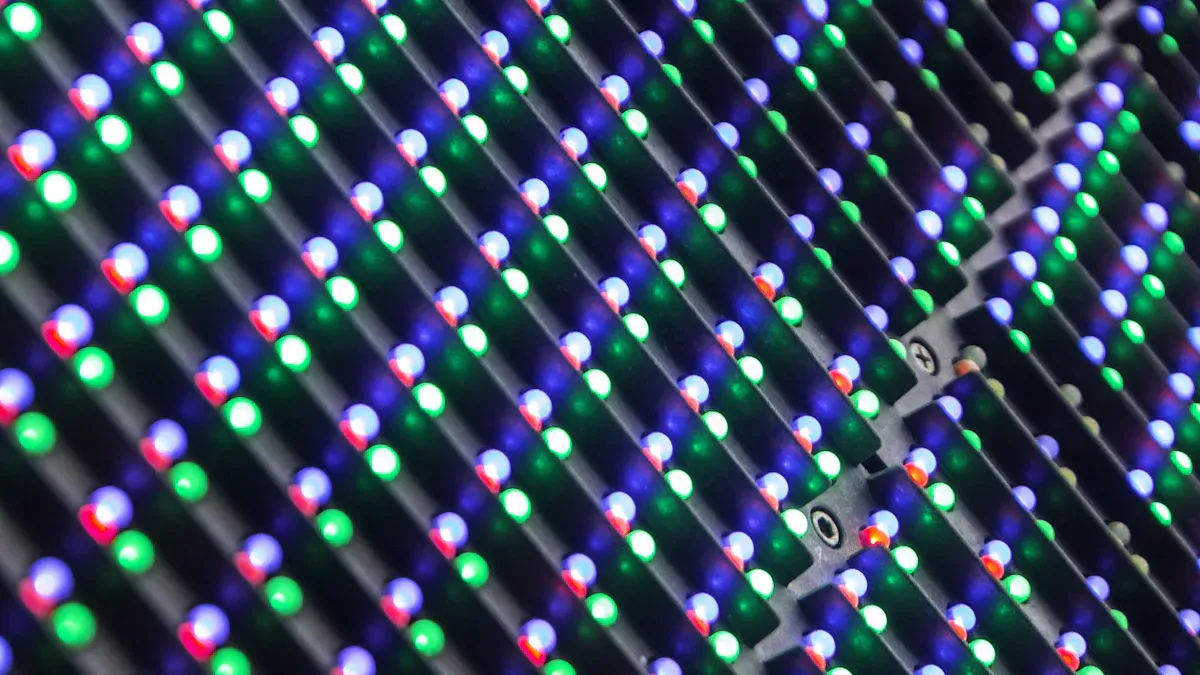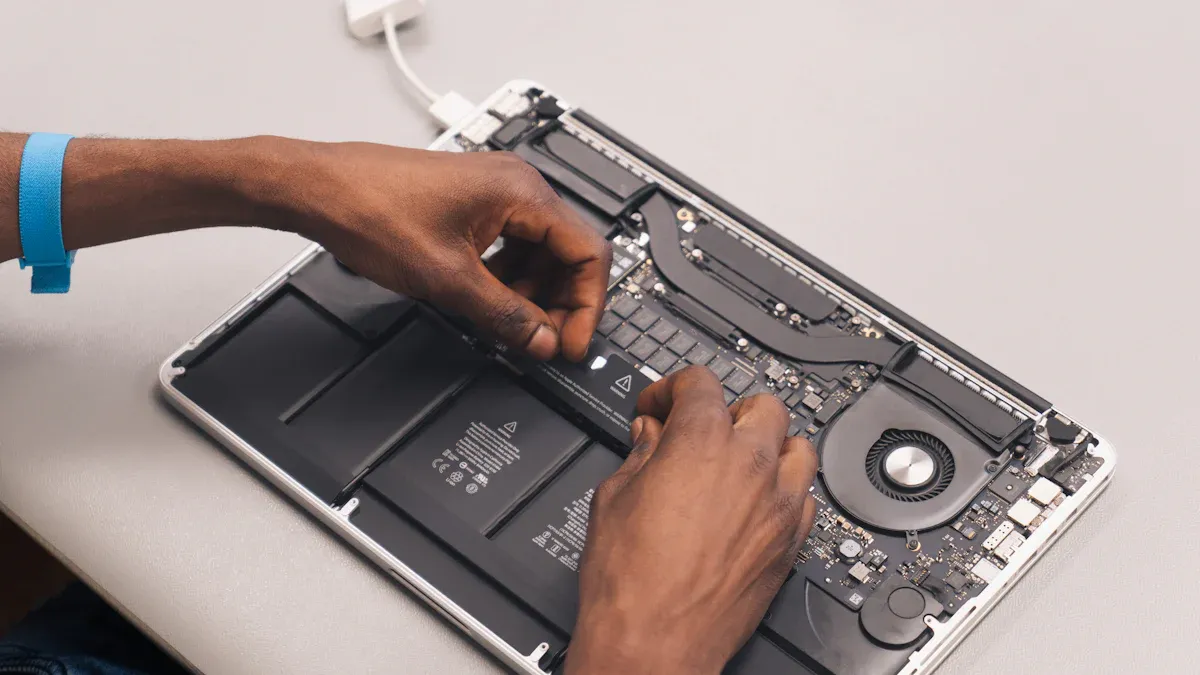What Causes White Spots on LCD Screens and How to Deal with and Prevent Them
Many people notice a lcd screen white spot while using their laptop. Imagine opening a laptop to finish homework and finding a bright spot that will not disappear, maybe we will to miss important details during a class on a laptop,or when we are in important meetings. Now let me tell you the solution to the white spot problem.
Key Takeaways
Reason:White spots on LCD screens oftenare usually caused by screen compression, accidental drops, dust that has not been cleaned for a long time, component aging, or backlight problems.
How to solve:Users should try simple fixes like rebooting, updating drivers, and gentle cleaning before seeking professional help.
Avoid pressing on the screen, using harsh cleaners, or opening the laptop without training to prevent further damage.
Handle laptops carefully, clean screens properly, use screen protectors, and store devices safely to prevent white spots.
Regularly inspect your laptop screen to catch issues early and keep your display clear and long-lasting.
LCD Screen White Spot Causes

Pressure Damage
Pressure damage often leads to a bright patch on laptop screen displays. When someone presses too hard on a laptop, the LCD layers can shift or break. This type of screen damage usually appears after dropping a laptop or stacking heavy items on it. Even a short period of pressure can cause a lcd screen white spot.
So We should avoid placing objects on closed laptops to prevent this kind of damage.
Backlight Issues
A bright patch on laptop screen displays can also result from backlight problems. The backlight sits behind the LCD and provides brightness. If the backlight shifts or its diffuser moves, it creates uneven lighting. This issue often looks like a lcd screen white spot or a glowing area. Backlight damage may happen after a laptop falls or receives a strong impact.
Dust or Debris
Tiny particles can slip inside a laptop and settle between the screen layers. Dust or debris sometimes causes a bright patch on laptop screen surfaces. These particles block or reflect light, leading to visible spots. Cleaning the laptop in a dusty area increases the risk of screen damage. Users should keep laptops closed when not in use to avoid this problem.
Manufacturing Defects
Some laptops leave the factory with hidden flaws. Manufacturing defects may cause a white patch on laptop screen surfaces soon after purchase. These defects can include uneven layers or loose components inside the screen. If a bright patch on laptop screen areas appears without any clear reason, a defect may be the cause. Warranty coverage often helps in these cases.
Aging Components
Over time, laptop screens wear out. Aging components may develop a lcd screen white spot or other display issues. The glue holding the layers together can weaken. The backlight may fade or shift. Water damage can speed up this process and cause permanent screen damage. Regular inspection helps catch these problems early.
Fix White Spots

Identify the Cause
Before anyone can fix white spots on a laptop, they must first find the source of the problem. Users should start by checking if the white spot changes when they move the screen or adjust the brightness. If the spot stays in the same place, the issue likely comes from hardware.
But sometimes, a software glitch or outdated driver causes display problems. We can reboot the laptop and update the display drivers to rule out software issues. If the white spot remains after these steps, the problem usually involves the screen itself and we need professional repair.
Tip: Take a clear photo of the white spot. This helps when seeking repair or warranty support.
DIY Solutions
If our laptop has not been accidentally dropped or crushed, we can try to fix it ourselves before seeking professional repair services.
Dust or Debris:If dust or debris causes the white spot, gentle cleaning may help. Use a microfiber cloth and a safe screen cleaner. Never press hard on the laptop screen.
For minor software issues:updating drivers or resetting display settings can sometimes fix white spots. If the laptop uses a removable battery, a full shutdown and restart may help. However, most hardware issues need more than simple cleaning or software updates.
Common DIY Steps:
Reboot the laptop.
Update display drivers.
Clean the screen with a microfiber cloth.
Check for dust under screen protectors.
If these steps do not work, we should not try to open the laptop themselves. Attempting to repair internal parts without training can cause more damage.
Professional Repair
When diy fixes do not solve the problem, professional repair becomes necessary. Trained technicians can open the laptop and inspect the screen layers. They know how to handle delicate components and avoid further damage. We should choose professional repair for issues like pressure damage, backlight failure, or aging components.
First, confirm whether your product is still under warranty. If the laptop is under warranty, the manufacturer may cover the repair cost. In some cases, the technician may need to replace the laptop screen to fully fix white spots.
If the warranty period has expired, you will have to bear these costs yourself. Some repair shops offer free diagnostics. This way, we can get an idea of the approximate repair costs and decide whether to repair it or buy a new laptop.
Note: Always back up important files before sending a laptop for professional repair.
Professional repair offers several advantages:
Technicians use the right tools.
Repairs often come with a warranty.
The process is safer for the laptop.
What to Avoid
Many users want to fix white spots quickly, but some actions can make things worse.
Avoid These Mistakes:
Never press on the white spot or use sharp objects to poke the screen.
Avoid using harsh chemicals or abrasive materials when cleaning.
Do not try to open the laptop unless you have proper training.
Using too much force or the wrong tools can damage the screen beyond repair.
Warning: Improper repair attempts can void the laptop warranty.
By following these guidelines, we can fix white spots safely or know when to seek professional repair.
Prevent LCD Screen White Spot
Handle with Care
Laptop users can avoid many screen problems by handling their devices gently. Carrying a laptop with two hands reduces the risk of dropping it. Closing the lid softly helps protect the screen from sudden impacts. Heavy objects should never rest on top of a closed laptop. Even a short period of pressure can cause a white spot to form. Students and professionals should always place their laptop on a flat, stable surface. Careful handling remains the first step in preventing future bright patches.
Tip: Always use a padded laptop bag when traveling. This extra layer shields the device from bumps and drops.
Clean Properly
A clean screen not only looks better but also lasts longer. Dust and debris can scratch the surface or slip inside the layers. To clean your screen, use a microfiber cloth and a gentle screen cleaner. These products remove smudges without leaving streaks or causing damage. Avoid paper towels, tissues, or any abrasive materials. Harsh chemicals like alcohol or ammonia can weaken the screen and cause permanent marks. Never press hard while cleaning, as too much force can create a white spot.
Safe Cleaning Checklist:
Use a dry microfiber cloth for daily dusting.
Apply a small amount of screen cleaner to the cloth, not directly to the laptop.
Wipe in gentle, circular motions.
Let the screen air dry before closing the laptop.
Use Screen Protectors
Screen protectors add a layer of defense against scratches and dust. They help keep the laptop display safe from minor bumps and fingerprints. When installing a screen protector, avoid trapping air bubbles or dust underneath. These can create bright spots or reduce visibility. Always follow the instructions that come with the protector. If a bubble appears, gently lift the edge and smooth it out with a soft card. Never use sharp tools or press too hard during installation.
Note: Check the screen protector regularly for signs of wear or trapped debris. Replace it if it becomes damaged.
Store Safely
Proper storage keeps a laptop safe when not in use. Store the device in a cool, dry place away from direct sunlight. Avoid leaving the laptop in a car or near heaters, as extreme temperatures can damage the screen. Never stack heavy books or objects on top of a closed laptop. Pressure from above can cause internal screen damage and lead to white spots. Use a dedicated laptop sleeve or compartment in a backpack for extra protection.
Storage Do’s and Don’ts Table:
Do | Don’t |
|---|---|
Use a padded laptop sleeve | Stack items on the laptop |
Store on a flat surface | Leave in hot or cold places |
Keep away from liquids | Place near edges of tables |
Regular Inspection
Regular inspection helps us spot problems early. Check the laptop screen for dust, smudges, or new spots every week. Look for signs of pressure damage or aging, such as fading or discoloration. Inspect the area around the hinges and edges, as these spots often show the first signs of trouble. If a screen protector is in use, check for trapped dust or air bubbles. Early detection allows users to fix small issues and prevent future issues before they become serious.
Reminder: Set a monthly reminder to inspect and clean the laptop. Consistent care extends the life of the device and helps prevent white spots.
By following these steps, we can reduce the risk of white spots. Preventing future bright patches starts with simple, regular care.
A lcd screen white spot often appears because of pressure, dust, aging parts, or backlight problems. Regular inspection helps users spot issues early. Gentle cleaning and careful handling protect the laptop screen from damage. Using a screen protector and storing the laptop safely also prevent future problems. These simple habits keep the laptop display clear and reduce the need for repair. Anyone can extend the life of a laptop by following these easy steps.
FAQ
What causes a white spot to suddenly appear on an LCD screen?
A white spot often appears after pressure or impact. Sometimes, dust or a backlight issue creates the spot. Aging parts can also cause this problem. Users should check for recent drops or heavy objects on the device.
Can software updates fix white spots on a laptop screen?
Software updates rarely fix white spots caused by hardware issues. If the spot comes from a software glitch, updating drivers or restarting the device may help. Most white spots need hardware repair.
Is it safe to keep using a laptop with a white spot?
A small white spot does not harm the laptop right away. The spot may grow if the cause is pressure or damage. Users should monitor the spot and seek repair if it gets worse.
How can someone tell if a white spot is from dust or hardware damage?
Dust spots may move or change when cleaning the screen. Hardware damage causes spots that stay in the same place. Users can gently clean the screen to check for dust.
Will a screen protector prevent all white spots?
A screen protector helps guard against scratches and dust. It cannot stop white spots from pressure, drops, or internal defects. Users should still handle the device with care.